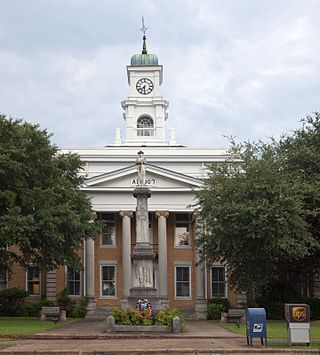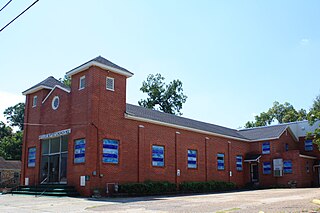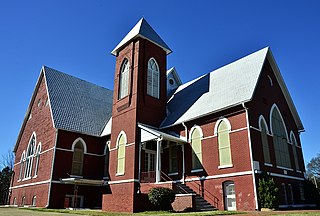
Hale County is a county located in the west central portion of the U.S. state of Alabama. As of the 2020 census, the population was 14,785. Its county seat is Greensboro. It is named in honor of Confederate officer Stephen Fowler Hale.

Eufaula is the largest city in Barbour County, Alabama, United States. As of the 2010 census the city's population was 13,137.

Dexter Avenue Baptist Church is a Baptist church in Montgomery, Alabama, United States, affiliated with the Progressive National Baptist Convention. The church was designated as a National Historic Landmark in 1974 because of its importance in the civil rights movement and American history. In 1978 the official name was changed to the Dexter Avenue King Memorial Baptist Church, in memory of Dr. Martin Luther King Jr., who was pastor there and helped organize the Montgomery bus boycott in 1955 during the civil rights era. The church is located steps away from the Alabama State Capitol.
Ruth Bolden (1910–2004) was a library founder and civil rights worker. She helped found what would become the Weaver-Bolden Branch Library in Tuscaloosa, Alabama, which is now named in honor of her and of Dr. George Weaver.

Beulah is an unincorporated community in the northeast corner of Lee County, Alabama, United States, just south of Valley. It is part of the Columbus, Georgia-Alabama Metropolitan Area. It is bounded by Chambers County on the north, the Chattahoochee River on the east, and the Halawaka Embayment of Lake Harding on the south.

The Ebenezer Missionary Baptist Church is a church on the National Register of Historic Places in Auburn, Alabama. Ebenezer Baptist Church was the first African American church built in the Auburn area after the end of the Civil War in 1865. Over the next few years, the church members built the church out of hand-hewn logs, transported from miles away by mules. The church was completed around 1870 and served the Ebenezer congregation until 1969. The building was restored in 1970 by the Auburn Heritage Association, and currently houses the Auburn Unitarian Universalist Fellowship.

The 16th Street Baptist Church is a Baptist church in Birmingham, Alabama, United States. In 1963, the church was bombed by Ku Klux Klan members. The bombing killed four young girls in the midst of the Civil Rights Movement. The church is still in operation and is a central landmark in the Birmingham Civil Rights District. It was designated as a National Historic Landmark in 2006. Since 2008, it has also been on the UNESCO list of tentative World Heritage Sites.

St. Luke's Episcopal Church is a historic Carpenter Gothic church, built during the 1850s at Cahaba, the first capital of Alabama from 1820 to 1826. The unknown builder closely followed plans published by architect Richard Upjohn in his 1852 book Rural Architecture.
First African Baptist Church may refer to:

Stone Street Baptist Church is a historic African-American Baptist church in Mobile, Alabama. The congregation was established well before the American Civil War, with Stone Street Baptist recognized today as one of Alabama's most influential African-American Baptist churches. It was placed on the National Register of Historic Places on August 8, 1985.

The First Presbyterian Church is a historic Greek Revival church building in Eutaw, Alabama. The two-story frame structure was built for the local Presbyterian congregation in 1851 by David R. Anthony. Anthony was a local contractor who constructed many of Eutaw's antebellum buildings. The congregation was organized by the Tuscaloosa Presbytery in 1824 as the Mesopotamia Presbyterian Church. John H. Gray served as the first minister from 1826 until 1836. The church was added to the National Register of Historic Places on December 16, 1974, due to its architectural and historical significance. The church is a member of the Presbyterian Church in America.

St. Louis Street Missionary Baptist Church is a historic African American church in Mobile, Alabama. It was added to the National Register of Historic Places on October 8, 1976, due to its architectural and historic significance.

Aimwell Baptist Church is a historic African American church in Mobile, Alabama. The Baptist congregation was established in 1890 by two brothers. It took two years for the erection of the first building. The current building, with Gothic Revival influences, was designed in 1946 by Nathaniel Heningburg and incorporates elements from the original structure. It was added to the National Register of Historic Places on May 29, 2008.

Mt. Olive Missionary Baptist Church No.1 is a historic Missionary Baptist church building in Mobile, Alabama. The church was built in 1916 by the local African American community. It was added to the National Register of Historic Places on May 29, 2008, based on its architectural significance.
New Hope Baptist Church may refer to:

The Dr. John R. Drish House, also known simply as the Drish House, is a historic plantation house in Tuscaloosa, Alabama, United States. It is considered by state preservationists to be one of the most distinctive mixes of the Greek Revival and Italianate styles in Alabama. First recorded by the Historic American Buildings Survey in 1934, it was added to the Alabama Register of Landmarks and Heritage on July 31, 1975, and subsequently to the state's "Places in Peril" listing in 2006. It was listed as Jemison School-Drish House on the National Register of Historic Places in 2015.

First Baptist Church is a historic church at 709 Martin Luther King, Jr. Street in Selma, Alabama. A historically African American Baptist church, it was built in the Gothic Revival style in 1894 and known for its association with the Civil Rights Movement. It was added to the National Register of Historic Places in 1979.
Bloody Tuesday was a march that occurred on June 9, 1964, in Tuscaloosa, Alabama, during the Civil Rights Movement. The march was both organized and led by Rev. T. Y. Rogers and was to protest against segregated drinking fountains and restrooms in the county courthouse. The protest consisted of a group of peaceful African Americans walking from The First African Baptist Church to the Tuscaloosa County Courthouse; however, protesters did not get very far before being beaten, arrested, and tear gassed by not only police officers standing outside the church, but a mob of angry white citizens as well.
















